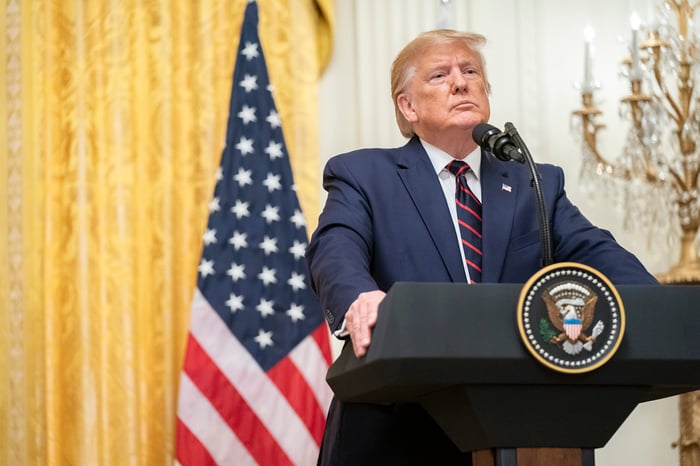The S&P 500 (^GSPC -1.11%), widely viewed as a barometer for the entire U.S. stock market, has advanced 26% year to date. That puts the index on pace to return more than 20% for the second consecutive year, something it last did during the dot-com bubble in 1997 and 1998.
Factors contributing to that upside include a resilient labor market, cooling inflation, and strong corporate earnings growth. Enthusiasm about artificial intelligence (AI) has also played a big role in sending the S&P 500 higher. But investors are now looking ahead to 2025, wondering how the market will perform when President-elect Donald Trump returns to the White House.
History offers mixed insight. On one hand, the S&P 500 performed very well during Trump's first presidency, and some analysts anticipate strong returns in his second term driven by deregulation and tax cuts. On the other hand, the S&P 500 currently trades at an expensive valuation, which hints at turbulence in the coming months and years.
Here's what investors should know.
The S&P 500 returned 70% during Donald Trump's first term as president
Investors should bear in mind that presidents do not control the stock market. However, they can influence it by shaping policies that impact the economy. For instance, Donald Trump signed the 2017 Tax Cuts and Jobs Act into law during his first term as president. That legislation not only reduced taxes for individuals, but also cut the corporate tax rate to its lowest level since 1939.
Lower taxes means more disposable income for consumers and higher profit margins for businesses, both of which tend to promote spending and economic growth. Indeed, U.S. gross domestic product (GDP) increased at 2.7% on an annualized basis from 2017 to 2019, above the average of 1.5% seen in the previous decade. Of course, GDP fell sharply in 2020 during the initial stage of the COVID-19 pandemic, but the stock market quickly surged after its initial plunge and delivered exceptional returns during Trump's first four years.
Specifically, the S&P 500 advanced 70% during that time, which is equivalent to 14.1% annually. That is significantly higher than the long-term average of about 7% annually. In fact, since the S&P 500 was created in 1957, the index performed better under Trump than any president except Bill Clinton, as shown below.
|
U.S. President |
Years in Office |
S&P 500 Annualized Return |
|---|---|---|
|
Dwight Eisenhower |
1957-1961 |
7.8% |
|
John Kennedy |
1961-1963 |
5.4% |
|
Lyndon Johnson |
1963-1969 |
7.6% |
|
Richard Nixon |
1969-1974 |
(4.1%) |
|
Gerald Ford |
1974-1977 |
10.4% |
|
Jimmy Carter |
1977-1981 |
6.3% |
|
Ronald Reagan |
1981-1989 |
10.2% |
|
George Bush |
1989-1993 |
10.9% |
|
Bill Clinton |
1993-2001 |
15.2% |
|
George W. Bush |
2001-2009 |
(6.2%) |
|
Barack Obama |
2009-2017 |
13.8% |
|
Donald Trump |
2017-2021 |
14.1% |
|
Joe Biden |
2021-Present |
11.6% |
Data source: YCharts, The American Presidency Project. Note: Returns are measure from one Inauguration Day to the next for most presidents. Exceptions include the assassination of John Kennedy and the resignation of Richard Nixon.
Donald Trump will inherit a much more expensive stock market in 2025
The S&P 500 had a forward price-to-earnings (PE) ratio of 22.2 as of Dec. 20, according to Yardeni Research. Excluding the current year, the last time the benchmark index traded at a such an expensive valuation was April 2021, according to FactSet Research.
Between 1980 and this year, the S&P 500's forward P/E multiple had only topped 22 during two general periods. The first time was the dot-com bubble and its aftermath, when it spent long stretches above that level. The second time was the first year or so of the COVID-19 pandemic, when it sat near 22 and occasionally went above (again, most recently in April 2021). In both cases, long stretches of gains ended with steep pullbacks -- nearly 50% when the dot-com bubble burst and just over 25% in the 2022 bear market.
Based on the relationship between the forward P/E value and subsequent stock market performance, the current multiple implies an annualized return of 3% over the next three years, according to Apollo Global Management Chief Economist Torsten Slok.

Donald Trump addresses the press during his first term as president. Official White House photo by Shealah Craighead.
Importantly, the S&P 500 had a forward P/E ratio around 17 when Trump first became president in 2017, and the multiple generally stayed below 18 until the pandemic. That means Trump is set to inherit a much more expensive stock market this time, so the S&P 500 may perform much worse than it did during his first presidency.
Investors can prepare for that possibility by tempering their expectations, paying attention to valuations, and building larger-than-normal cash positions in their portfolios. Remember, the S&P 500 has historically suffered a correction about once every two years, and a bear market about once every six years. But drawdowns have always been buying opportunities, and investors with cash on hand can capitalize on the next drawdown whenever it arises.


![Trump at White House podium. Official White House Photo by D. Myles Cullen. [MConverter.eu]](https://g.foolcdn.com/image/?url=https%3A%2F%2Fg.foolcdn.com%2Feditorial%2Fimages%2F802201%2Ftrump-at-white-house-podium-official-white-house-photo-by-d-myles-cullen-mconvertereu.jpg&op=resize&w=92&h=52)


